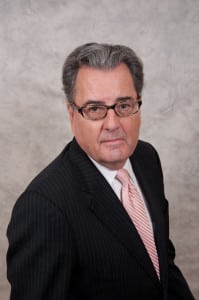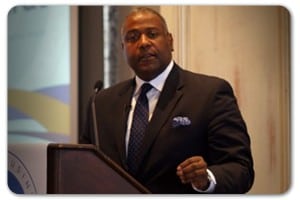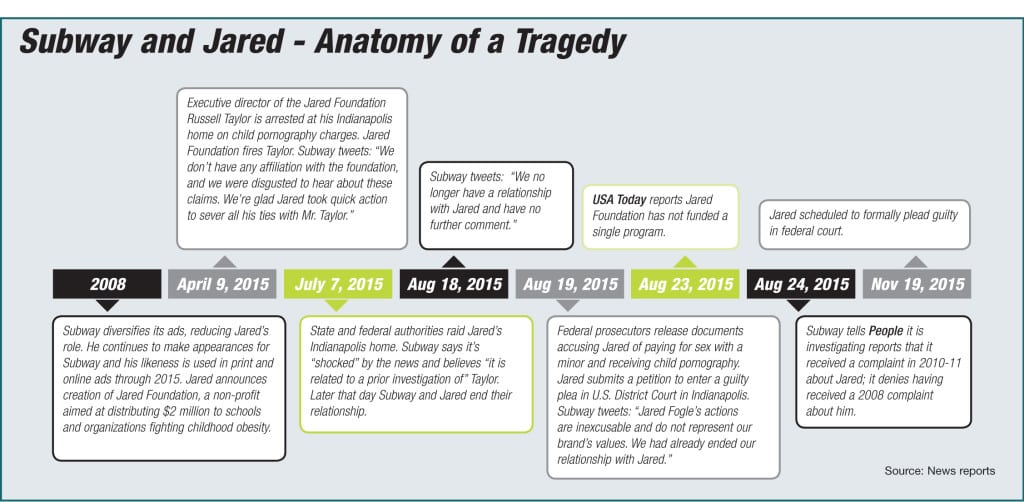While a very ugly matter that allegedly has victimized children, the Jared Fogle-Subway affair is a major story and one that the PR community continues to watch, debate and possibly learn from. With that in mind, we asked PR thought leaders how they would counsel Subway during the next 3-5 months. We also asked how communicators at brands indirectly related to the story, namely hotels Jared Fogle stayed at when he allegedly committed crimes, should strategize in the coming months.
While these are difficult questions, they are more strenuous for PR strategists because some of the incident’s details remain fluid and unclear. What is certain is that 15-year Subway pitchman Jared Fogle, 38, recently agreed to plead guilty to charges of receiving and distributing child pornography and having sex with minors [please see timeline below]. The court has yet to finalize Jared’s proposed settlement, however. The other open issue concerns Subway’s knowledge of Jared’s personal life. Federal authorities said they found no evidence Subway knew of Jared’s alleged activities. In response to reports that two complaints about Jared were brought to Subway, in 2008 and 2010-11, the company issued a short statement last week to People magazine. Subway said it had no record of receiving the 2008 complaint. A former Subway franchisee allegedly filed that complaint. After hearing press reports about the 2010-11 complaint “we began an investigation that is ongoing,” Subway said.
The consensus from those we interviewed is Subway must tell the truth, and fast, if it knew anything about Jared’s alleged crimes. Beyond that, the level of transparency recommended varied, as did tactics and strategies.

VP, Communication & Outreach,
Southwest Airlines
Get Back to Storytelling: “One of the biggest issues [from a PR perspective] is that Subway’s brand voice has been muddled by this controversy, which is unfortunate,” Rutherford says. “The most important thing for Subway to do now is to quickly and concisely figure out a way to get back to telling the story of its brand.” One of the problems with that, however, is “they can’t easily go back to telling their story, which was about the health of their sandwiches, because Jared is stuck in the middle of it…he’s so closely associated with the health story.”
Endorsements Are Tricky: This incident shows how careful brands need to be about who owns their voice, Rutherford says. “In this day and age of hyper-transparency, very little is not known about people. That gives all brands the charge to be extra-cautious about who’s going to own their brand voice,” she says. “And if it’s someone outside the firm you have decide how to do that and for how long…celebrity voices/endorsements are trickier today than they’ve ever been.”

The Truth Is Job One: “The main question Subway needs to answer is what, if anything, it knew and when,” Nielsen says. “They pulled back from having [Jared] as their prime spokesperson in their advertising campaign in 2008.” The allegation floating around is that Subway received complaints about his personal life in 2008-09, so maybe it knew. “The first job now is to find out if any of their executives, prior or current, knew about [Jared’s activities].”
Communications and Senior Executives: Telling the truth is critical in a crisis, Nielsen says, and there is some confusion with Subway. “Subway said it knew nothing [about Jared’s activities], and now it says there’s an ongoing investigation” of a complaint. “Communications at Subway needs to have a heart-to-heart with senior executives and find out if anyone knew anything…communications needs all the facts because it will have to figure out a plan to move forward from this.” Nielsen says it’s “important in a crisis for communications to have a good relationship with the senior team. If not, [communications] is constantly tripping over itself” trying to fix things.
Move Quickly: Should it turn out Subway knew, “they have to come clean fast and then apologize to the victims and figure out what they are going to do to regain trust from the community…I would look into nonprofits that aid victims of sexual abuse, find out the best one to give a large donation to.”
If its investigation turns up nothing, Nielsen says, “it still would be nice to make a donation to a victims group, but I would advise against it. Too many customers would presume it’s an admission of guilt.”

Truth Telling: Getting an investigation done is critical and should be undertaken immediately, Cody says, agreeing with Nielsen (above). “If there’s a smoking gun, Subway should address it yesterday.” He recommends using all communications means, including social media, and “tailoring the message to each particular channel,” he says.
Rolling Heads: Should the investigation find Subway had prior knowledge of Jared’s activities “it should be mea culpa, heads need to roll and new policies put into place…emphasize that ‘Jared has been gone for a while and we’ve moved on’…do a bit of what [Jeff] Bezos did, ‘This is not my Amazon, this is not my Subway.’” His reasoning: “If it turns out Subway knew something, that information will come out and if it does, it could be the Watergate of fast food.” Unlike Nielsen who feels Subway generally has done a good job, Cody feels it’s been “dragging its heels…I’m reading between the lines, but it seems legal counsel is getting in the way of [Subway] being transparent.”
Share the Investigation: In fact, Cody urges Subway to provide the public with “periodic updates on its internal investigation…the topline findings at least,” he says. Subway’s lawyers, he believes, will try to “prevent anything from coming out” as they are worried by the possibility of backlash against the company from the families of minors Jared allegedly interacted with.
Subway is particularly vulnerable, Cody says, because it’s “the good guy of fast food as it’s wrapped itself in wellness and health. When a company like that goes south, it tends to take an extra-heavy hit.”

Slow Down: “Stop feeding the story,” Jarrell says at the outset of our interview. “The Jared part of the story is over; he’s agreed to plead…. Any comment [Subway] makes should begin with ‘Jared has not been our [main] spokesman since 2008.’ Put the onus on the judicial system, emphasize that this has nothing to do with [Subway] at all,” he says.
Investigation Mistake: “It was a mistake to acknowledge an internal investigation,” he says, disagreeing with Cody (above). “That keeps the story alive…mainstream media is not interested in investigations.” Fortunately, he says, only a few outlets are following it now. “The attention span of media is extremely short, unless you keep feeding it…Subway doesn’t have to respond to everything.” He urges monitoring social media. “That’s where the story lives now…I expect interest will drop off rapidly…unless Subway makes it a story.” He also urges Subway to speak directly to the two people who allegedly complained about Jared.
“Subway is under no obligation to release news of the investigation…this should be an internal HR process,” Jarrell insists. “You’ve opened the investigation door, now shut it gently so you can do your fact finding.” He applauds Subway for purging Jared from its Web site. “The site is to promote product,” he says.
Prepare Scenarios: Have scenarios ready should the investigation show someone at Subway had knowledge of Jared’s personal life, he says. A communications person should be privileged to be able to coordinate between communications and legal, he says. “The lawyers likely are concerned because if someone at Subway was told of Jared’s activities, the company could be culpable.”

Keep the Investigation Quiet: “Now that Subway has let the public know it is investigating, I would counsel against releasing partial information from the investigation,” Rubinson says. “I’d also be preparing to act in case there were individuals who knew [about Jared’s activities]. And you should announce [any actions in that regard]. If you find that nobody knew, you announce that, too, but be careful. Do market research to understand if the public has moved on….If so, you might want to avoid announcing the results and dredging up the story again. Should the story remain alive, you probably should announce that the investigation found nobody at Subway had knowledge [of Jared’s private affairs].”
Consumer Gain: “I’d be offering consumers the $5 foot-long sandwich for a period of months,” to help take the focus off of Jared.
Be Transparent, Fast and Suspend Someone: “My general advice in this era of social media justice is to understand that the world rushes to judgment quickly,” Rubinson says. “So when you have allegations as serious as these you need to move quickly to suspend someone [which Subway did by severing its relationship with Jared], even if you’re waiting to better understand the legal ramifications and whether or not [that person is] actually guilty. Even if it’s unfair, you have to suspend someone.” Moving fast is key, she adds and be as transparent as possible, “even while you’re gathering facts…everything should be done with sincerity and you must be genuine.”

Lie Low: “If Subway can keep an arm’s length from Jared’s behavior, I’d do little or nothing in terms of communications,” Gilman says. “The issue will be if Jared’s actions [can be linked] to the company…if there was knowledge at Subway of his actions…they have a problem…if not, the average consumer will not go to Quiznos instead of Subway.” Still, “I’d leave no stone unturned, so Subway can be sure nobody had knowledge [of Jared’s activities]. To be effective, [communicators] need to be confident nobody knew.”
Transparency Is Critical: “The only way to handle this is transparently…allowing your legal team to lead when you’re dealing with reputation/brand management is a huge mistake,” Paul says. “In these situations legal and PR must try to respect each other…when you lead from fear [and reduce transparency], you make mistakes.” Lawyers are trained to make the court of law the priority, so they tend to forget about the court of public opinion he says. Paul’s self-styled “building blocks” for reputation management begin with truth, followed by honesty, humility, transparency, accountability and consistency. “We teach our kids all these things. Unfortunately,” he says, “adults stink at them....I’d counsel Subway’s board to put this framework in place,” although its lawyers won’t like it.

“No Comment” Is Deadly: “When you create an information void by saying ‘No comment,’ you allow others to fill that gap…and when people don’t know, they guess at the extremes.” His advice? “Subway should admit it picked Jared. ‘We didn’t know enough about [his private life]. We’re sorry these things occurred, we apologize to the children and families involved and to our customers, who’ve had to hear about these incidents…and we have a new policy we’ve added which will include all our employees, whether they are spokespeople or staff who work in our restaurants. We’ve come up with a deeper due diligence process to make sure we protect our brand and you, the customer.’”
CONTACT: [email protected]; [email protected]; [email protected]; [email protected]; @lrubinson; [email protected]; [email protected]
What Should the Hotels Do?
Subway is one of several brands involved in the Jared Fogle affair. The others include NYC hotels, such as the Plaza and Ritz-Carlton, where Jared allegedly engaged in sexual acts with a minor. Jared was in NYC in November 2012 to promote Team Subway at the NYC Marathon. He resided at the Plaza, where he allegedly had sex with a 17-year-old girl. Subway paid for the trip. He returned to NY in January 2013 and had sex with the girl at a Ritz-Carlton.
Fortunately the Plaza and Ritz-Carlton are major brands with sophisticated communications teams accustomed to monitoring media stories involving events that occur on their properties. Indeed, monitoring the media, including social media, is critical at this time, says Roger Conner, former VP of communications at Marriott. “In cases like this, hotels are innocent victims, yet you must move quickly to protect the brand…immediacy is critical,” he adds. Reputation specialist Mike Paul agrees. “The minute a [hotel] brand is mentioned in a story, it has communicators monitoring the news,” he says. The hotels will “need to monitor this for the next several months,” says Andy Gilman, of CommCore Consulting. Ritz-Carlton is a luxury arm of Marriott. The Plaza is a Fairmont property.
That the brands involved are hotels is an advantage. “[Unsavory acts occurring on their property] is nothing new to major hotels,” Paul says. As a result these brands’ communications teams have plenty of experience with such cases, he says. “Hotels are like mini cities,” adds Gilman, “everything goes on in them.”
The public-facing part of the communicator’s job now, Conner says, involves brand spokespeople referring media inquiries about specifics of the affair to legal authorities. Typically hotels have a policy prohibiting releasing information about guests. Now that legal authorities have stated Jared resided at the hotels on specific dates, the hotels typically would confirm the dates, Conner says. In addition, spokespeople should say the hotel is cooperating with authorities during this situation, he adds.
“Should the decision be made to release a longer, proactive statement,” Conner says, “it should include language that the brand abhors the activity Jared allegedly engaged in and finds it troubling.” Paul agrees, noting hotels’ desire for discretion, which is a major selling point for them, he says. Despite the need for discretion, “I favor sending a strong message [using a proactive statement] as it shows the brand’s concern for child molestation, Paul says. Something like, ‘We have a zero tolerance policy [for underage sex]. We heard about [Jared] the same way you did [from legal authorities]. When we discover such incidents occurring in our hotel we report them to police immediately.’” Gilman would avoid a larger statement. “[Once the authorities have released details of activities in the hotel] the hotel can confirm it, but I wouldn’t comment on the brand’s rules and policies for guests,” he says.
In addition, the hotels, Conner says, should say something like, “We have in place and will redouble surveillance against unlawful activity on our property and always will report such incidents to the police.” In Marriott’s case, Conner says, “it’s important to invoke that the brand has worked globally for many years in the fight against the underage sex trade and has made monetary contributions” to it. Now a communications consultant to hotels, Conner refused to provide details of how Marriott or other hotel brands decide to issue a longer statement.
For emergency situations, such as 9/11 or the 2008 incident when 52 people were killed during a terrorist bombing at the Marriott in Islamabad, Pakistan, Marriott uses what it calls a First-Hour Document, Conner says. The protocol calls for the brand’s crisis communication team to take charge. Conner emphasizes the team is composed of representatives from a “wide range” of company functions. The document has a set of scripted activities that should be carried out within one hour of learning about a crisis.
CONTACT: Roger Conner is president of Conner Communications. He can be reached at: [email protected]
This article originally appeared in the August 31, 2015 issue of PR News. Read more subscriber-only content by becoming a PR News subscriber today.


Subway can roll to increased success by using the local: releases sent by a national distributor like Cision or the news wires to local media in the name of local Subway restaurants reaching their local customers. Goal: speak not just TO consumers and dealers but FOR consumers and dealers by advocating local action to protect local people. We cherish the spokesmen who advocate what we believe in.